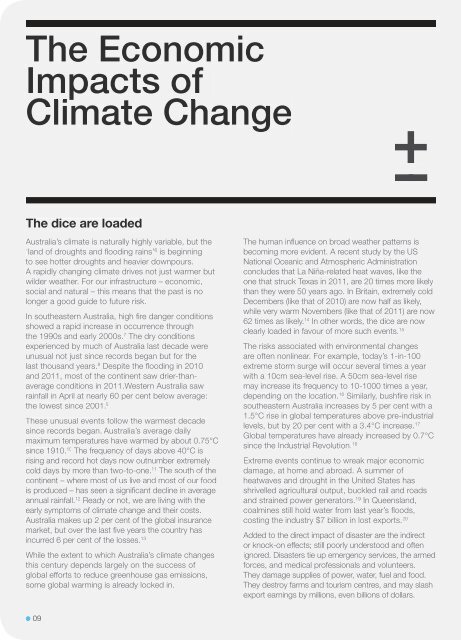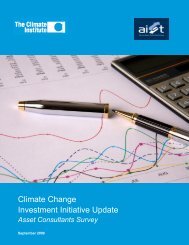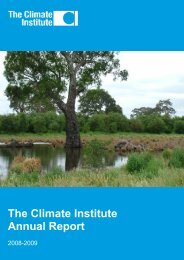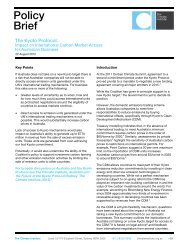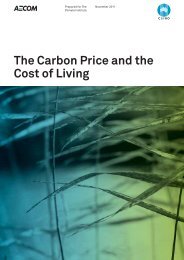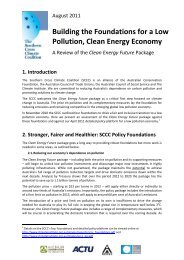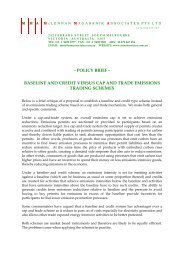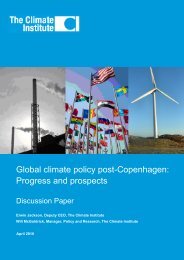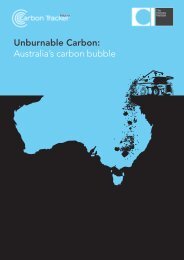Coming Ready or Not - The Climate Institute
Coming Ready or Not - The Climate Institute
Coming Ready or Not - The Climate Institute
You also want an ePaper? Increase the reach of your titles
YUMPU automatically turns print PDFs into web optimized ePapers that Google loves.
<strong>The</strong> Economic<br />
Impacts of<br />
<strong>Climate</strong> Change<br />
+<br />
--<br />
<strong>The</strong> dice are loaded<br />
Australia’s climate is naturally highly variable, but the<br />
‘land of droughts and flooding rains’ 6 is beginning<br />
to see hotter droughts and heavier downpours.<br />
A rapidly changing climate drives not just warmer but<br />
wilder weather. F<strong>or</strong> our infrastructure – economic,<br />
social and natural – this means that the past is no<br />
longer a good guide to future risk.<br />
In southeastern Australia, high fire danger conditions<br />
showed a rapid increase in occurrence through<br />
the 1990s and early 2000s. 7 <strong>The</strong> dry conditions<br />
experienced by much of Australia last decade were<br />
unusual not just since rec<strong>or</strong>ds began but f<strong>or</strong> the<br />
last thousand years. 8 Despite the flooding in 2010<br />
and 2011, most of the continent saw drier-thanaverage<br />
conditions in 2011.Western Australia saw<br />
rainfall in April at nearly 60 per cent below average:<br />
the lowest since 2001. 9<br />
<strong>The</strong>se unusual events follow the warmest decade<br />
since rec<strong>or</strong>ds began. Australia’s average daily<br />
maximum temperatures have warmed by about 0.75°C<br />
since 1910. 10 <strong>The</strong> frequency of days above 40°C is<br />
rising and rec<strong>or</strong>d hot days now outnumber extremely<br />
cold days by m<strong>or</strong>e than two-to-one. 11 <strong>The</strong> south of the<br />
continent – where most of us live and most of our food<br />
is produced – has seen a significant decline in average<br />
annual rainfall. 12 <strong>Ready</strong> <strong>or</strong> not, we are living with the<br />
early symptoms of climate change and their costs.<br />
Australia makes up 2 per cent of the global insurance<br />
market, but over the last five years the country has<br />
incurred 6 per cent of the losses. 13<br />
While the extent to which Australia’s climate changes<br />
this century depends largely on the success of<br />
global eff<strong>or</strong>ts to reduce greenhouse gas emissions,<br />
some global warming is already locked in.<br />
09<br />
<strong>The</strong> human influence on broad weather patterns is<br />
becoming m<strong>or</strong>e evident. A recent study by the US<br />
National Oceanic and Atmospheric Administration<br />
concludes that La Niña-related heat waves, like the<br />
one that struck Texas in 2011, are 20 times m<strong>or</strong>e likely<br />
than they were 50 years ago. In Britain, extremely cold<br />
Decembers (like that of 2010) are now half as likely,<br />
while very warm Novembers (like that of 2011) are now<br />
62 times as likely. 14 In other w<strong>or</strong>ds, the dice are now<br />
clearly loaded in favour of m<strong>or</strong>e such events. 15<br />
<strong>The</strong> risks associated with environmental changes<br />
are often nonlinear. F<strong>or</strong> example, today’s 1-in-100<br />
extreme st<strong>or</strong>m surge will occur several times a year<br />
with a 10cm sea-level rise. A 50cm sea-level rise<br />
may increase its frequency to 10-1000 times a year,<br />
depending on the location. 16 Similarly, bushfire risk in<br />
southeastern Australia increases by 5 per cent with a<br />
1.5°C rise in global temperatures above pre-industrial<br />
levels, but by 20 per cent with a 3.4°C increase. 17<br />
Global temperatures have already increased by 0.7°C<br />
since the Industrial Revolution. 18<br />
Extreme events continue to wreak maj<strong>or</strong> economic<br />
damage, at home and abroad. A summer of<br />
heatwaves and drought in the United States has<br />
shrivelled agricultural output, buckled rail and roads<br />
and strained power generat<strong>or</strong>s. 19 In Queensland,<br />
coalmines still hold water from last year’s floods,<br />
costing the industry $7 billion in lost exp<strong>or</strong>ts. 20<br />
Added to the direct impact of disaster are the indirect<br />
<strong>or</strong> knock-on effects; still po<strong>or</strong>ly understood and often<br />
ign<strong>or</strong>ed. Disasters tie up emergency services, the armed<br />
f<strong>or</strong>ces, and medical professionals and volunteers.<br />
<strong>The</strong>y damage supplies of power, water, fuel and food.<br />
<strong>The</strong>y destroy farms and tourism centres, and may slash<br />
exp<strong>or</strong>t earnings by millions, even billions of dollars.<br />
Global Warming<br />
Figure 1.0<br />
Australians can be very resilient, but the loss of<br />
<strong>Climate</strong> change raises the probability of extreme events nonlinearly.<br />
Bushfire risk in southeastern Australia increases by 5 per cent with a<br />
livelihoods and loved ones takes a heavy toll. Violent<br />
1.5°C rise in global temperatures above pre-industrial levels, and by<br />
st<strong>or</strong>ms, heat waves, fires and floods injure adults and<br />
20 per cent with a 3.4°C increase. Global temperatures have already<br />
children, mentally as well as physically, which, apart<br />
increased by 0.7°C since the Industrial Revolution.<br />
from the personal suffering, means higher welfare,<br />
productivity and health costs. 21 <strong>The</strong> cost of insurance<br />
rises, and large sums of (often public) money are<br />
needed to cover the uninsured and repair damaged<br />
infrastructure, communities and industries.<br />
% Increase in Bushfire Risk<br />
25<br />
20<br />
15<br />
10<br />
5<br />
0<br />
0.9<br />
1.5<br />
3.4 °C<br />
(above pre-industrial temperatures)<br />
10


